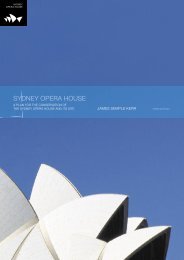nomination by the Government of Australia - Sydney Opera House
nomination by the Government of Australia - Sydney Opera House
nomination by the Government of Australia - Sydney Opera House
Create successful ePaper yourself
Turn your PDF publications into a flip-book with our unique Google optimized e-Paper software.
24<br />
Part 2. Description<br />
The <strong>Sydney</strong> <strong>Opera</strong> <strong>House</strong> literally became a testing<br />
laboratory and a vast, open-air precasting factory.<br />
Examples <strong>of</strong> engineering and technological feats and<br />
o<strong>the</strong>r innovations are described in Part 3.A.<br />
The <strong>Sydney</strong> <strong>Opera</strong> <strong>House</strong> took 16 years to build at an<br />
estimated cost <strong>of</strong> A$102 million. This was six years<br />
longer than scheduled and 10 times more than its<br />
original estimated cost (Murray 2004: xv). Weston<br />
points out that it was miraculous that Utzon was given<br />
so much freedom to explore, experiment and succeed<br />
in building <strong>the</strong> structure at all (Weston 2002: 184).<br />
Certainly it was expensive and diffi cult to build,<br />
but so were Gothic ca<strong>the</strong>drals and many<br />
o<strong>the</strong>r major buildings, and part <strong>of</strong> <strong>the</strong>ir appeal<br />
is <strong>the</strong> feeling <strong>of</strong> embodied energy and effort<br />
expended in achieving a great work … [But] as<br />
<strong>the</strong> fi rst and still unrivalled modern ‘blockbuster<br />
building’, it must have paid for itself many<br />
times over <strong>by</strong> giving <strong>Sydney</strong> and <strong>Australia</strong> an<br />
unrivalled and instantly recognisable emblem—<br />
‘<strong>the</strong> greatest public-relations building since <strong>the</strong><br />
pyramids’ to quote an <strong>Australia</strong>n MP (Weston<br />
2002: 184).<br />
Probably <strong>the</strong> most signifi cant feature <strong>of</strong> <strong>the</strong><br />
whole <strong>Sydney</strong> <strong>Opera</strong> <strong>House</strong> story is <strong>the</strong><br />
astonishing reality that in a modern society with<br />
all its checks and balances, its accountants<br />
and accountability, its budgets and budgetary<br />
controls, a folly <strong>of</strong> this scale could be<br />
contemplated. In o<strong>the</strong>r words it is nothing<br />
short <strong>of</strong> miraculous that it happened at all<br />
(Zunz 1973: 2).<br />
2.27 2.28<br />
Figure 2.27 Paul Robeson sings to <strong>the</strong> construction workers<br />
in 1960<br />
The <strong>Sydney</strong> <strong>Opera</strong> <strong>House</strong> as a performing<br />
arts centre<br />
Many famous artistic performers from <strong>Australia</strong> and<br />
overseas have been associated with <strong>the</strong> <strong>Sydney</strong><br />
<strong>Opera</strong> <strong>House</strong>. The fi rst performance at <strong>the</strong> <strong>Sydney</strong><br />
<strong>Opera</strong> <strong>House</strong> took place in 1960, long before it<br />
<strong>of</strong>fi cially opened, when <strong>the</strong> American actor and singer<br />
Paul Robeson climbed onto <strong>the</strong> scaffolding at <strong>the</strong><br />
construction site to sing to <strong>the</strong> workers. Thirteen<br />
years later <strong>the</strong> fi rst <strong>of</strong>fi cial performance was given<br />
in <strong>the</strong> <strong>Opera</strong> Theatre on 28 September 1973 <strong>by</strong> <strong>the</strong><br />
<strong>Australia</strong>n <strong>Opera</strong> Company. On 20 October 1973 <strong>the</strong><br />
<strong>Sydney</strong> <strong>Opera</strong> <strong>House</strong> was <strong>of</strong>fi cially opened <strong>by</strong> Queen<br />
Elizabeth II. During <strong>the</strong> period immediately after <strong>the</strong><br />
opening some 300 journalists arrived from all over <strong>the</strong><br />
world ‘to see if <strong>the</strong> <strong>Sydney</strong> <strong>Opera</strong> <strong>House</strong> was to be a<br />
white elephant or a sacred cow’ (Kerr 1993: 25). A Los<br />
Angeles correspondent wrote:<br />
This, without question, must be <strong>the</strong> most<br />
innovative, <strong>the</strong> most daring, <strong>the</strong> most dramatic<br />
and in many ways, <strong>the</strong> most beautifully<br />
constructed home for <strong>the</strong> lyric and related<br />
muses in modern times (Kerr 1993: 25).<br />
A timeline <strong>of</strong> <strong>the</strong> <strong>Sydney</strong> <strong>Opera</strong> <strong>House</strong> is at<br />
Appendix 10.D.<br />
Figure 2.28 Aerial view <strong>of</strong> <strong>the</strong> <strong>Sydney</strong> <strong>Opera</strong> <strong>House</strong> during<br />
its opening on 20 October 1973

















